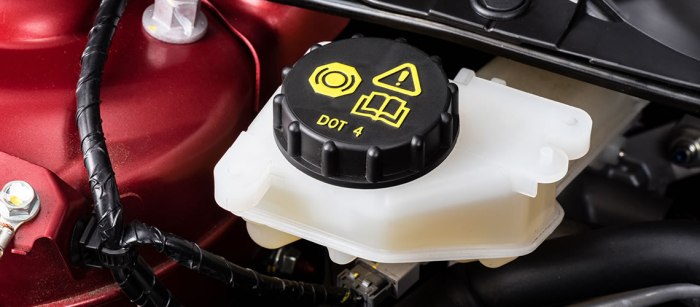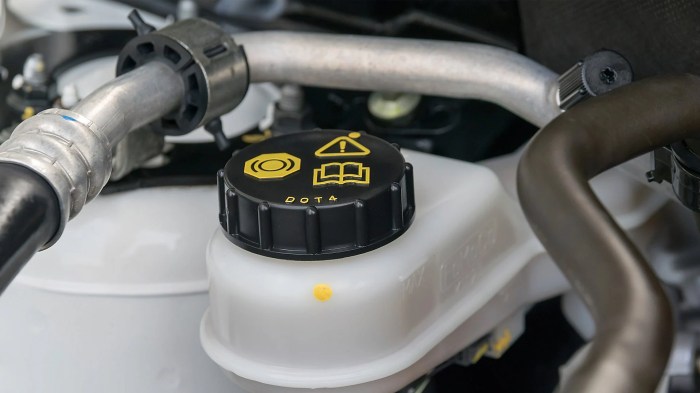Kicking off with How to check and refill your car’s brake fluid, this opening paragraph is designed to captivate and engage the readers, setting the tone informal but serious style that unfolds with each word.
Brake fluid is a crucial component in your car’s braking system, ensuring hydraulic pressure for effective braking. From understanding the types of brake fluids to checking levels and refilling when needed, this guide covers it all.
Understanding Brake Fluid
Brake fluid is a vital component in a car’s braking system, responsible for transferring force from the brake pedal to the brake calipers, resulting in the application of braking force.
Role of Brake Fluid in Maintaining Hydraulic Pressure
Brake fluid plays a crucial role in maintaining hydraulic pressure within the braking system. When the brake pedal is depressed, the brake fluid transmits this force to the brake calipers, causing them to squeeze the brake pads against the rotors, resulting in the vehicle coming to a stop.
Looking for the best SUVs for off-road adventures? Check out our list of top-rated SUVs for off-road adventures that are ready to take on any terrain with ease.
Types of Brake Fluid
- DOT 3: This type of brake fluid is glycol-based and is commonly used in most vehicles. It has a lower boiling point compared to DOT 4 and DOT 5 fluids.
- DOT 4: Also glycol-based, DOT 4 brake fluid has a higher boiling point than DOT 3 fluid, making it suitable for vehicles that undergo heavy braking or high temperatures.
- DOT 5: Silicone-based brake fluid, DOT 5 is less hygroscopic than glycol-based fluids, making it less prone to absorbing water. However, it is not compatible with anti-lock braking systems (ABS) and can cause brake failure if mixed with other types of brake fluid.
Checking Brake Fluid Levels
When it comes to checking your car’s brake fluid levels, it’s essential to know where to find the brake fluid reservoir and the correct steps to follow for a proper check.
Locating the Brake Fluid Reservoir
The brake fluid reservoir is typically located under the hood of your car, near the back of the engine compartment. It is a small, translucent plastic container with “Max” and “Min” markings on the side to indicate the fluid levels.
Step-by-Step Guide to Checking Brake Fluid Levels
- Ensure your car is parked on a level surface and the engine is turned off. This will prevent any accidents or injuries while inspecting the brake fluid.
- Open the hood of your car and locate the brake fluid reservoir. The cap is usually labeled with “Brake Fluid” for easy identification.
- Wipe the reservoir cap and surrounding area clean to avoid any dirt or debris from falling into the brake fluid when you open it.
- Slowly unscrew the cap and check the fluid level against the “Max” and “Min” markings on the side of the reservoir. The brake fluid level should be between these two marks.
- If the level is below the “Min” mark, it’s time to add more brake fluid to prevent any potential brake issues.
- After checking the level, securely tighten the cap back onto the reservoir to prevent any leaks or contamination.
Optimal Conditions for Checking Brake Fluid Levels
It’s best to check the brake fluid level when the engine is cold to avoid any potential burns from hot engine components. Additionally, make sure the car is parked on a level surface to get an accurate reading of the fluid level in the reservoir.
Refilling Brake Fluid
When the brake fluid level is low in your car, it is crucial to refill it promptly to ensure your brakes function properly. Here’s how to refill your car’s brake fluid and some important tips to keep in mind.
Type of Brake Fluid Recommended
It is essential to use the type of brake fluid recommended by your vehicle’s manufacturer. Typically, most vehicles use either DOT 3 or DOT 4 brake fluid. Using the correct type is important because different brake fluids have varying boiling points and viscosity, which can affect brake performance.
Curious about the latest trends in automotive design and engineering? Stay up to date with the latest trends in automotive design and engineering to see what’s shaping the future of cars.
Process of Refilling Brake Fluid
- Locate the brake fluid reservoir under the hood of your car.
- Clean the area around the reservoir to prevent any contamination when opening it.
- Remove the reservoir cap and check the fluid level. If it is below the ‘minimum’ mark, it needs to be refilled.
- Top up the reservoir with the recommended brake fluid until it reaches the ‘maximum’ mark.
- Avoid overfilling the reservoir as it can lead to brake issues.
- Securely close the reservoir cap and ensure it is tightly sealed.
- Double-check the fluid level to ensure it is within the recommended range.
Tips for Refilling Brake Fluid
- Always use a clean funnel to avoid any dirt or debris from entering the brake fluid reservoir.
- Avoid mixing different types of brake fluid as it can cause damage to the braking system.
- If you are unsure about the type of brake fluid to use, refer to your vehicle’s owner’s manual or consult a professional mechanic.
- Regularly check the brake fluid level and top up as needed to maintain optimal brake performance.
Signs of Brake Fluid Issues

Brake fluid is a critical component of your vehicle’s braking system, and it is essential to recognize the signs of potential brake fluid problems to ensure your safety on the road.
Spongy Brake Pedal
If you notice that your brake pedal feels spongy or soft when you press on it, this could be a sign of air in the brake lines or low brake fluid levels. Air in the brake lines can compromise the effectiveness of your brakes and should be addressed immediately.
Warning Light on Dashboard
Another common sign of brake fluid issues is the illumination of the brake warning light on your dashboard. This light indicates a potential problem with your brake system, including low brake fluid levels or other issues that require attention.
Leaking Brake Fluid, How to check and refill your car’s brake fluid
If you observe puddles or stains under your vehicle that are a reddish-brown color, this could be a sign of leaking brake fluid. Brake fluid leaks can lead to a loss of braking power and should be addressed promptly to prevent safety hazards.
Risks of Driving with Low Brake Fluid Levels
Driving with low brake fluid levels can result in decreased brake performance, longer stopping distances, and potential brake failure. In extreme cases, insufficient brake fluid can lead to a complete loss of braking ability, putting you and others at risk of accidents.
When to Seek Professional Help
If you experience any of the signs mentioned above or suspect brake fluid issues, it is crucial to seek professional help immediately. A qualified mechanic can inspect your brake system, identify the root cause of the problem, and perform the necessary repairs to ensure your safety on the road.
Last Recap: How To Check And Refill Your Car’s Brake Fluid

By now, you should feel confident in your ability to maintain your car’s brake fluid at optimal levels. Remember to keep an eye out for signs of issues and seek professional help when needed to ensure your safety on the road.